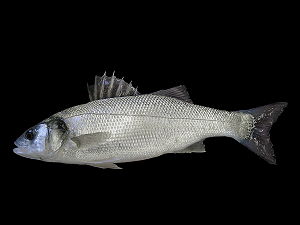Sea bass
| Sea bass | ||||||||||||
|---|---|---|---|---|---|---|---|---|---|---|---|---|

European sea bass ( Dicentrarchus labrax ) |
||||||||||||
| Systematics | ||||||||||||
|
||||||||||||
| Scientific name | ||||||||||||
| Moronidae | ||||||||||||
| Jordan & Evermann , 1896 | ||||||||||||
The sea bass (Moronidae) or striped bass are a family with two genera and six species with different distribution areas.
features
The animals are 45 cm to two meters tall. The fish are silvery with seven to eight longitudinal stripes on the flanks. Your body is moderately elongated and somewhat flattened on the sides. The head and body are covered with large comb scales. They have two short spines on the gill cover . The gill cover is round and slightly sawn. The mouth is large, the maxillary extended, and a supramaxillary is missing. There are rows of small, conical teeth in the mouth. Special fangs are missing. The base of the tongue is also provided with two rows of small teeth, and there are teeth on the ploughshare (vomer) and the palatine bone (palatine). The number of Branchiostegal rays is seven. Of a total of 25 vertebrae, 12 are trunk vertebrae and 13 are tail vertebrae located behind the anus.
The lateral line organ is continuous and extends to the base of the caudal fin . It is accompanied by 50 to 72 pored scales. The swim bladder extends into a cavity of the first fin ray carrier (pterygiophore) of the anal fin.
The dorsal fin is clearly divided by an indentation. The last fin spine is in the second dorsal fin. The anal fin lies below or behind the soft-rayed part of the dorsal fin. The pectoral fins are small and asymmetrical, the upper rays are longer. The caudal fin is forked and heavily scaled at its base. It is supported by eight to nine fin rays, seven to eight of which are branched.
Fin formula : dorsal 1 VIII – X, dorsal 2 I / 10–13, anals III / 9–12, pectorals 15–18, ventral I / 5.
Internal systematics and distribution
There are two genera with a total of six species. The four species of the genus Morone live in North America in rivers that flow into the Atlantic Ocean and the Gulf of Mexico . The two species of the genus Dicentrarchus are marine . They live in the eastern Atlantic from Norway and Iceland to Senegal, the Canary Islands , the Mediterranean and Black Seas and, more recently, in the North Sea .
- Genus Dicentrarchus
- European sea bass ( Dicentrarchus labrax ) (Linnaeus, 1758)
- Spotted sea bass ( Dicentrarchus punctatus ) (Bloch, 1792)
- Genus Morone
- Morone americana (Gmelin, 1789)
- Morone chrysops (Rafinesque, 1820)
- Morone mississippiensis (Jordan & Eigenmann in Eigenmann, 1887)
- Morone saxatilis (Walbaum, 1792)
use
Some species are used as food fish for human consumption:
- European sea bass : important food fish, also called branzino or loup de mer in kitchen language .
- Spotted sea bass : not a main target fish for commercial fishing, but sport fishermen do after it.
Fossil record
A fossil sea bass of the genus Morone from the Oligocene was found near Wiesbaden and Priscacara with several thousand finds, one of the most common fish genera in the North American, Eocene Fossil Butte Member , is now part of the sea bass family.
Individual evidence
- ^ Karl Albert Frickhinger: Fossil Atlas Fish , Mergus-Verlag, Melle, 1999, ISBN 3-88244-018-X
- ^ Whitlock, JA, 2010. Phylogenetic relationships of the Eocene percomorph fishes Priscacara and Mioplosus. Journal of Vertebrate Paleontology 30 (4): 1037-1048, July 2010 by the Society of Vertebrate Paleontology. PDF
literature
- Joseph S. Nelson : Fishes of the World . John Wiley & Sons, 2006, ISBN 0-471-25031-7 .
- PC Heemstra: Moronidae Temperate basses. Pages 1294 to 1296 in FAO Species Identification guide for Fishery Purposes: The Living Marine Resources of the Western Central Atlantic, Volume 2 Bony fishes part 1 (Acipenseridae to Grammatidae) , ISSN 1020-6868
Web links
- Sea bass on Fishbase.org (English)
